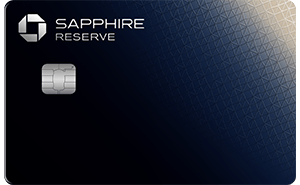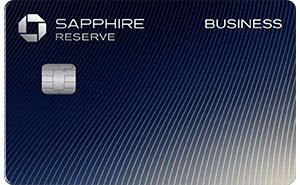How to Make the Most of Chase Sapphire Reserve
Chase Sapphire Reserve's annual fee is steep. You can get a lot in return for it, but you’ll need to put in some work.

Many or all of the products on this page are from partners who compensate us when you click to or take an action on their website, but this does not influence our evaluations or ratings. Our opinions are our own.
The Chase Sapphire Reserve® is a premium card with a massive slate of cardholder goodies. They include a drool-worthy sign-up bonus, ample spending rewards, a suitcase full of premium travel perks, travel credits worth hundreds of dollars annually and many lesser-known gems.
The list of benefits and rewards is dizzying — but you'll pay a hefty annual fee of $795 to get them. That makes it crucial to extract as much value from the card as possible. The card made some considerable changes in June 2025, which included adding a slew of “coupon book” benefits. This means that making the most of the Chase Sapphire Reserve® requires doing some math to track and spend these credits. You’ll also need to accumulate and spend rewards wisely to make the card worth holding.
Here's how to take full advantage of the card.
Earn the welcome offer
When you're approved for any new credit card, you want to meet the requirements to collect its welcome offer. This is especially important with the Chase Sapphire Reserve® because the bonus unlocks much of the card's upfront and overall value.
So you’ll want to use the card heavily at first. For many people, that means using it for everyday spending and large purchases. Big spenders who can meet the threshold easily might use it more strategically by spending mostly in the bonus categories of dining and travel. Just make sure you hit the required spending level by the deadline.
Balance transfers don’t count toward the required spending — and the card is a poor choice for balance transfers anyway, with no intro APR period and a fee of either $5 or 5% of the amount of each transfer, whichever is greater. The ongoing APR is 19.74%-28.24% Variable APR.
Rack up rewards points
The rewards on the Chase Sapphire Reserve® encourage you to keep using the card long after you've pocketed the bonus.
The card earns Chase Ultimate Rewards® points for spending in popular categories. If you book through Chase, you can earn even more. Here’s what you get:
8 points per dollar on all travel booked through Chase.
4 points per dollar spent on bookings made directly with an airline or hotel.
3 points per dollar spent at restaurants, including eligible food delivery. (10 points per dollar on Chase Dining purchases.)
1 point per dollar spent on all other purchases.
Points can be worth between 1 to 2 cents apiece when you use them to book travel via Chase. You can also choose to transfer them to one of Chase's multiple travel partners. (More on this later.)
Use the travel credit
The Chase Sapphire Reserve® is a general travel credit card that doesn’t require loyalty to a specific airline or hotel chain. That makes using its $300 annual travel credit much easier.
The card's daunting downside, the annual fee of $795, becomes a little easier to stomach if you use the travel credit. That lowers the effective cost of the card to $495 per year.
The travel credit is granted annually based on your cardholder anniversary. Unused credit doesn't carry over from year to year. Chase applies the credit automatically to your travel purchases, essentially erasing the first $300 worth each year. The credit applies to eligible travel purchases including airlines, hotels, taxi rides, train fares and more.
Redeem points for travel through Chase
Chase offers multiple ways to use your rewards points — cash back or gift cards at a rate of a penny per point, for example. But you may be able to get better value when you use them to book travel through Chase's travel portal. There, with the "Points Boost" redemption feature, cardholders can redeem their points at a value of up 2 cents apiece on eligible flights and hotel stay offers. This means that for bookings that qualify for Points Boost, your points can potentially be worth 100% more than their cash value.
All other point redemptions for travel through Chase that are not eligible for Points Boost are worth 1 cent each.
Note that when booking travel through Chase, there are no flight blackout dates.
The Points Boost redemption system was introduced in June 2025. For cardholders who had the Chase Sapphire Reserve® or applied for it before June 23, 2025, points earned before Oct. 26, 2025, can be redeemed at the prior 1.5 cents per point until Oct. 26, 2027. For points earned before Oct. 26, 2025, cardholders will automatically receive the best offer available (either through Points Boost or at 1.5 cents per point) until Oct. 26, 2027. The Points Boost system will take full effect for all cardholders beginning Oct. 26, 2027.
Transfer points for potentially more value
One option for redeeming your points is more limited but could yield even better value than booking through Chase: transferring points to a partner airline or hotel loyalty program.
You can transfer Chase Ultimate Rewards® points to one of Chase’s partner airlines or hotel loyalty programs at a 1:1 rate.
For example, say you found a $500 United Airlines flight for 25,000 miles at united.com. You could convert 25,000 Chase Ultimate Rewards® points into 25,000 United miles and then pay for the ticket with them, giving you a redemption rate of 2 cents per point.
Max out on yearly credits
Prior to the Chase Sapphire Reserve®’s annual fee increase from $550 to $795, earning the welcome bonus, using those points to book travel through Chase and using your annual travel credit essentially covered the annual fee for years. But with an annual fee approaching the $1,000 threshold, making the most of the card now requires putting in some work to keep track of and use its slew of credits that add up to many hundreds of dollars in value per year:
Up to $500 in credit for The Edit, Chase’s high-end hotel portal, in the form of two $250 credits a year.
Up to $300 in credit at restaurants in the Sapphire Reserve Exclusive Tables program. You get this as two separate credits of $150 in each half of the year.
Up to $300 in statement credit for StubHub, in the form of two $150 credits a year.
Up to $250 toward Apple TV+ and Apple Music subscriptions.
Up to $120 in credit toward Peloton membership, available at $10 a month. Plus you earn 10 points per dollar on eligible Peloton purchases.
Complimentary IHG One Rewards Platinum Elite Status through Dec. 31, 2027.
If you spend $75,000 or more on the card each year, you’ll also get a $500 credit for Southwest Airlines flights booked through Chase and Southwest A-List status. You also get IHG One Rewards Diamond Elite Status, plus a $250 credit for purchases through The Shops at Chase.
You can also take advantage of the card’s food delivery perks through its partnership with DoorDash. Chase Sapphire Reserve® cardholders get $300 in credits for DoorDash purchases — in the form of a monthly $5 restaurant promo and two $10 promos to spend on groceries, beauty, electronics and more — plus a $120 DashPass membership, through Dec. 31, 2027, or a minimum of 12 months, depending on when you activate.
Also, through Sept. 30, 2027, the card offers $10 a month in Lyft credit, plus 5X points on Lyft rides.
Avoid other redemption options
You can also redeem points for cash, at a value of 1 cent per point, as a statement credit or electronic deposit into a checking or savings account. That's not terrible, but not necessarily as lucrative as redeeming for travel. Remember that a Points Boost deal could double that value, and you also have the option of transferring points to one of Chase's travel partners, also potentially for outsize value.
Gift cards are available but aren't a deal unless they're offered at a discount, making your points worth more than a penny each. Using points for Amazon shopping is an even worse deal; points there are worth 0.8 cent each.
Capitalize on other travel perks
The Chase Sapphire Reserve® includes other perks that add value:
Lounge access: Be sure to activate your included membership in Priority Pass Select, which gives you access to more than 1,000 airport lounges worldwide. Cardholders also have access to Chase's Sapphire Lounges, though they are currently only available in a handful of locations.
NEXUS, Global Entry or TSA Precheck: The card will reimburse you the application fee for NEXUS, Global Entry or TSA Precheck, programs that give you access to special — and often speedier — lines at airport security and customs. You are reimbursed for one of the three. All programs are good for five years, and you're eligible for reimbursements once every four years — presumably so you can reapply before your membership in a program expires. You must charge the application fee to the Chase Sapphire Reserve®, and you'll receive a statement credit automatically.
Rental car discounts: Discounts are available when booking with the card at National, Avis and Silvercar. You'll also get primary rental car insurance for up to $75,000 for theft and collision damage in the U.S. and abroad if you decline the rental company's collision insurance and charge the cost of the rental to your card. Some exclusions apply.
Team it with a different card
The bonus categories on the Chase Sapphire Reserve® are good for earning Chase Ultimate Rewards® points, but if you're willing to use a complementary card in tandem, you can rack up points even faster.
Two good choices from Chase also earn Chase Ultimate Rewards® points, which you can transfer to the Chase Sapphire Reserve® and redeem for travel at a potentially higher rate.
The Chase Freedom Flex® earns 5% back in rotating bonus categories on up to $1,500 in spending per quarter after activation (1% back on non-bonus-category purchases).
The Chase Freedom Unlimited® earns 5% cash back on travel purchased through Chase; 3% back at restaurants; 3% back on drugstore purchases; and 1.5% on all other non-bonus-category purchases.
Chase markets these as cash-back cards, but they earn rewards as points you can transfer to the Chase Sapphire Reserve®.
So, for example, if grocery stores are a quarterly bonus category for the Chase Freedom Flex®, you can earn 5 points per dollar spent instead of 1 point, at least up to the Chase Freedom Flex® spending limit of $1,500 per quarter.
Then, to get the most of those points, you could transfer them to your Chase Sapphire Reserve® account and book travel through Chase to get better value through Points Boost, if eligible.
The Chase Sapphire Reserve® is an enhanced version of the popular Chase Sapphire Preferred® Card, which has some similar but less lucrative features and a lower annual fee of $95. Read NerdWallet's comparison of these two cards to see how they stack up against each other.
How to redeem rewards on the Chase Sapphire Reserve®
To redeem your points:
Log into your Chase account.
Select "Ultimate Rewards” on the right side of the screen, and select the card you want to access. If you have several Chase cards, they’ll all be displayed together.
Choose how you’d like to use your points.
The Chase Sapphire Reserve® has oodles to offer frequent travelers, but it's worth getting only if you can extract enough value from its rewards and perks to outweigh the high annual fee. If you can take advantage of the card’s yearly credits and other specific benefits, then the card might make sense for you.
1x-8x
Points125,000
Points1x-5x
Points75,000
Points1x-8x
Points200,000
PointsFind the right credit card for you.
Whether you want to pay less interest or earn more rewards, the right card's out there. Just answer a few questions and we'll narrow the search for you.








